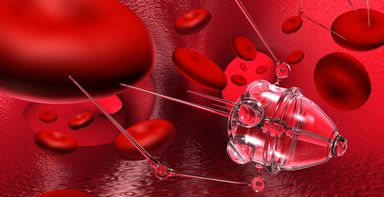Swarms of robots could fight cancer (with your help)

Current cancer treatments are far from ideal. Cancer researchers are thus not shy of using nanotechnology. Their work is making promising headway into developing safer and more effective treatments. And now, new developments in the area mean that the general public can help through crowdsourcing.
Cancer causes one in every four deaths in the US, and an estimated 12.7 million new cancer cases were diagnosed worldwide in 2008. Current treatments are far from ideal. For example, typical chemotherapies seep out of the blood stream after injection and spread throughout the body. The drugs are then free to attack all the cells encountered – even healthy ones – causing significant side effects.
This is obviously far from ideal. Bioengineers are therefore experimenting with nanoparticles that can deliver drugs and diagnostics directly to tumours. Nanoparticles are slightly bigger than drugs: around five to 500 nanometers, which is around 100 to 10,000 times smaller than a human hair. This special size allows them to leak out of the large pores in tumour vessels, and yet still be contained in the blood stream throughout the rest of the body. As a result, nanoparticles can passively accumulate in tumours while avoiding healthy tissue.
Nanoparticles come in different sizes, shapes and materials. They can be loaded with drugs that are released in a controlled fashion and coated with molecules that allow them to interact with their environment. Some of these molecules can be a signature to uniquely identify cancer cells. Upon binding, cells can engulf nanoparticles that then deliver their cargo within the cell.
There are many ways you can design a nanoparticle. Depending on your design, the nanoparticle will move, sense and act in different ways – just like a robot. Control is in the design of the nanoparticles and their interactions with the environment, rather than any intelligence inside it. In other words, changing the body of the nanoparticle will change its behaviour: we call it embodied intelligence.
The challenge is understanding which nanoparticle design will improve treatment outcome. This is a difficult problem because trillions of nanoparticles interact in a tumour with millions of cells. Predicting and optimising the behaviour of all these nanoparticles in such a complex system is guess work at best.
Swarm Control
Like our nanoparticles, flocks of birds, ant colonies, cells and robot collectives can exhibit seemingly complex swarm behaviours when large numbers of simple agents react to local information. Our goal now is to explore how nanoparticles can cooperate, or swarm, to synergistically improve their therapeutic effect.
Recent work by the Bhatia Laboratory at MIT shows promise in this direction ("Nanoparticles that communicate in vivo to amplify tumour targeting"). Gold nanoparticles would passively accumulate in the tumour. The nanoparticles would then be heated using a laser, thereby causing damage to the tumour tissue. The second wave of nanoparticles, engineered to bind to the damaged tissue, would therefore accumulate at higher numbers there.
Using a simulator that models how nanoparticles interact with each other and the tumour environment, we can now explore such nanoparticle swarm designs. In the video example, simulated nanoparticles leaving a blood vessel (in red) must find a rare cell (with a pink border) in the tumour tissue.
This rare cell could have a specific mutation, and its detection might help identify a pocket of cells resistant to treatment. By smartly engineering the nanoparticles and how they interact with their environment, we are able to mark direct paths from the vessels to the cell. Similar to ants forming trails to reach your picnic table, these nanoparticles work by depositing and interacting with information in the environment.
There are many such tumour scenarios and swarm strategies. Each one takes time to explore and requires large amounts of trial and error. Also, each problem is different, making it difficult to program a computer that can automatically design the nanoparticles.
Crowdsourcing therefore allows bioengineers and the general public to imagine new nanoparticle strategies towards the treatment of cancer. The simulator called Nanodoc predicts how nanoparticles behave in tumours and is based on years of research. The hope is that people using the simulator can help discover new, creative and efficient nanoparticle strategies that we haven’t thought of in the lab.
Source: Nanowerk News
The article can be found here (external link, Nanowerk News)
For further information, please contact:
info@innovationsgesellschaft.ch